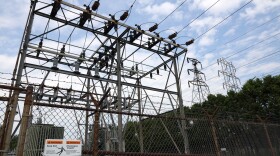From 1885 to 1986, the Ithaca Gun Company produced shotguns in a hillside factory northeast of downtown Ithaca. The factory’s smokestack still overlooks the city and Ithaca Falls.
In the years since, the site has been the focus of extensive environmental remediation. Now, stakeholders are approaching the beginning of the end of the cleanup.
When the company went bankrupt and left Ithaca, they left something behind, according to EPA spokesman Mike Basile. “Well, what we did discover, of course—and it wasn’t earth science to discover it—is that there was an awful lot of lead that was found on the site,” Basile says.
That lead came from the test firing of those Ithaca shotguns. Guns were test fired four times before they were sold, to make sure they were up to snuff.
The EPA was called in to perform an emergency cleanup. The agency worked on parts of the site from 2000 to 2004, using what were essentially big shop vacs to suck up the lead from the soil. “The site work really consisted of what we call turbo vacuuming of lead contaminated soil,” Basile explains.
But the EPA did not clean the factory itself. Basile says that’s because the agency didn’t consider it a hazard. There was also a developer who wanted to renovate the building for condos, but he ran out of money.
At that point, the City of Ithaca got involved, says Nels Bohn of the City of Ithaca’s Urban Renewal Agency. The city took ownership of part of the site for a park that will overlook Ithaca Falls. It also found a new developer for the other part of the site and a state grant to pay for part of the factory demolition.
“Without removing the building, it became apparent that it was not possible to truly safeguard to the public that the lead contamination sources were removed,” Bohn says. The factory was finally torn down in 2009.
After the demolition was complete, though, the city found something concerning.
“Some of those areas that EPA remediated now had a condition where there was some lead present at levels above 400 parts per million,” Bohn says. Four hundred parts per million is the cleanup standard for lead set by the New York State Department of Environmental Conservation.
The lead in the factory was never cleaned, and some of it likely spread when the factory was torn down, re-contaminating parts of the site.
On top of that, the factory sat on a steep hill and on the edge of a deep gorge. “And it appears that there has been active erosion of the fractured bedrock,” Bohn says. That erosion would have moved the lead downhill--lead that came from the factory building or from other areas not targeted by the EPA.
All this work didn’t come cheap. The building demolition cost $2.3 million and the city predicts it will cost them another $1.5 million to finish their cleanup. The current developer, Frost Travis, expects to pay $15 million finish his cleanup and build apartments, but he also says it’s not all about cost.
“I also like to look at it in terms of the benefit that it could provide for the community,” Travis says. One of those benefits is more housing, which Ithaca needs. Travis is also in an agreement with the city to pay for part of their proposed park.
For now, his portion of the site still isn’t clean, and he can’t finish that cleanup until the city finishes cleaning up their portion of the site.
Bohn said that work should begin soon. “We’re proposing to get back on the site by May and finish that work in the field in about 6 weeks,” he explains. Then, the city will only need final approval from the New York State DEC that their cleanup is done. Bohn says he hopes that will happen by the end of the year.
If it does, it could mean a new beginning for the former Ithaca Gun Factory site.







